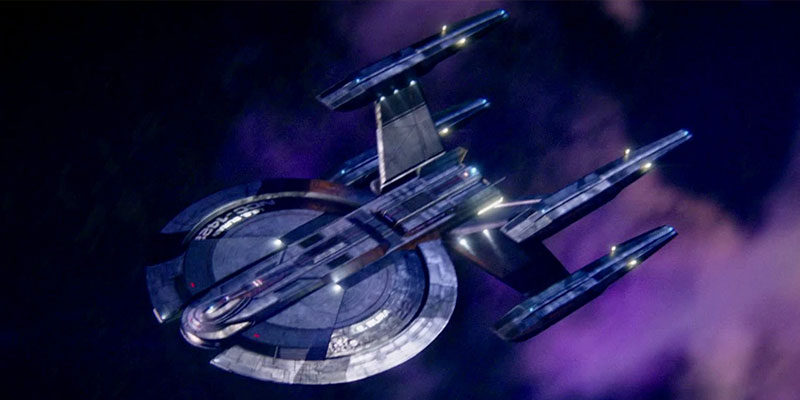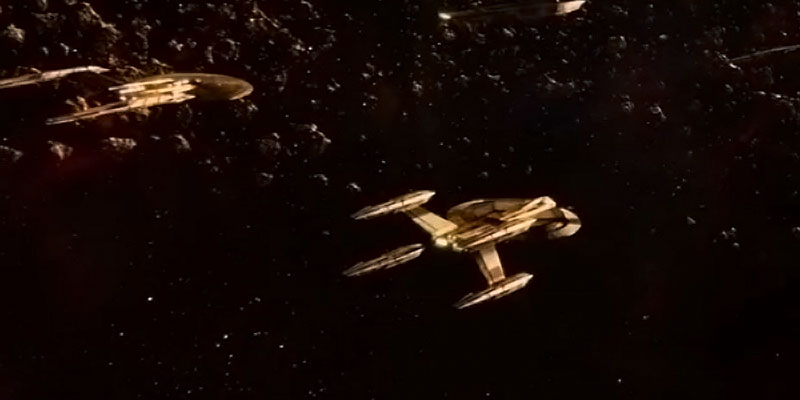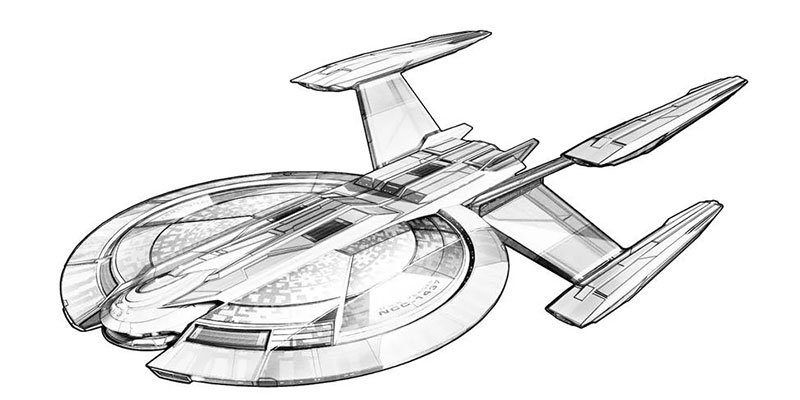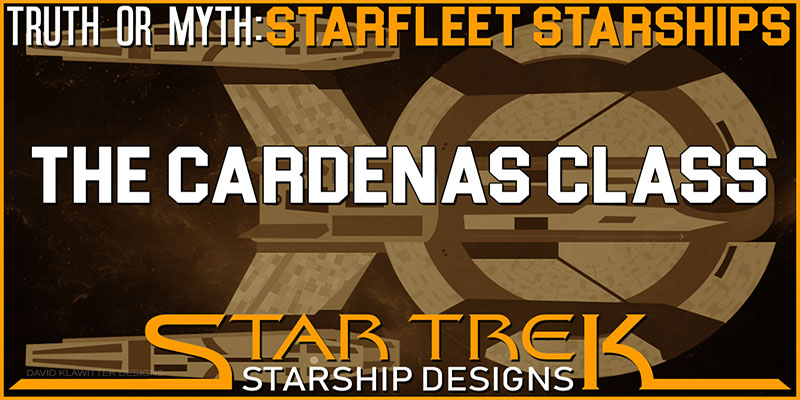Hello and welcome to another episode of Truth OR Myth, a Star Trek web series that normally looks at the Truth, or canon, information to dispel the myths that have surfaced on a given topic. Due to the successes of my previous Beta Canon starship videos, today’s episode will continue my current trend of being a bit different as we’re taking a look at the Cardenas Class of Starfleet Starships.
During the early to mid 23rd century, Starfleet Command will begin to experiment with several 4 warp nacelle starship designs… And one of these designs, the Cardenas class, would prove itself a valuable addition to the United Federation Of Planets…
There isn’t a lot of information available of this class, so what I’ve done is thoroughly researched the Class through Beta Canon and filled in some of the huge gaps with my imagination, all to give you good “Tri-naries” a little bit to chew on about this amazing class. As a result though, most information in the video should pretty much be taken with a grain of stardust, and only considered a little bit of Star Trek Fun!
I’d also like to give a huge shout out to German Trekkie who provided me with some of the Classes CGI shots.
Since the conception of Starfleet’s First Official Starship Class, the NX Class, Starfleet’s Core of Engineers had been debating the usefulness of additional warp nacelles above and beyond the standard 2 nacelles Starship Designs that Starfleet had been used to and known for.

Sure there were clear advantages to have more then the standard amount such as still being able to achieve higher warp speeds if 1 or more nacelles were rendered inoperative, a back up which Starfleet Command itself looked favourable on. And when all nacelles were operating it did, in fact, give a slight boost to a starships speed as the warp field generated by them could be more focused and operate at higher frequencies. However the downside being even more resources poured into these starship designs, along with requiring even more power to be generated by these starship warp cores made these design improvements dubious at best.
However, Starfleet has always been known to place the safety of the people serving within its organization as a primary focus, and so these additional nacelle designs would continue to be developed and explored all through out its starship design history, and in the early 23rd century one of these designs to be tested would be the Cardenas Class. Named after US Air Force Brigadier General Robert Cardenas who had piloted the B-29 plane that launched Chuck Yeager‘s first manned supersonic flight, the Cardenas Class had a length of approximately 441 meters and would be crewed by approximately 300 officers and crew members.
The design process on this class took far longer then any starship class at the time had. And as a result, would end up being designed and redesigned time and time again, as Starfleet’s Core of Engineers simply couldn’t lock down the specs for this class.
But when in 2243 at 24 years of age, Dr Richard Daystrom made his breakthrough in Duotronic Technology, this starship class would be one of the first to implement these breakthrough in its design. In fact, many of the newly designed Duotronic systems and computer controls would later end up being the basis for the computer systems aboard Starfleet Commands newest class the Constitution Class which would quickly become the jewel in Starfleet Starship design crown. Duotronics would allow this starship class to break the warp seven barrier, as it allowed more complicated and faster control over a starship warp fields.
Initially expected to only be able to achieve and maintain a warp factor of 7, old warp scale, the Cardenas class would surprise Starfleet by being the first Starfleet Starship Class to achieve and maintain a warp factor of 8. Though this warp factor was determined to be detrimental and dangerous to the ship, never the less it was a feat that would go down in Starfleet History books. As a result of these warp trials, however, the Cardenas Class would end up with a standard cruising speed of warp factor 6 and an emergency cruising speed of warp factor 7 making this class one of Starfleet’s fastest classes of the time.

This class would also have improved weapons capabilities, again testing a new weapons system intended on being utilized on the Constitution Class of Starfleet Starships, and that, of course, was Phaser Emitters. Up to this point in Starfleet Technological history, all starships were equipped with the latest Phase Cannon Systems. Although powerful, the intermittent nature of the Phase Canon beam was seen as a downside of that particular system. And so, when Starfleet Weapons Design Engineers came up with a way for a starship to emit a continuous beam of destructive phaser energy, Starfleet was only too happy to oblige and agreed to have the Cardenas Class equipped with this new system, along with the standard Phase cannon systems that were standard at the time.
All other systems, Including shield and torpedo technologies, would remain basically the same as what was installed in most other classes, the only real difference being in their Duotronic components.
Another interesting design change for this class, when compared to other classes of the time, would be it’s moving of the ships bridge module to edge of its primary hull, rather than the standard of most starships bridges being atop the centre of the saucer. This was done simply to give this starship class a more sleek look, rather than doing it for any beneficial intentions. And although this did work, in terms of aesthetics, this change was seen as a bigger flaw more than anything else. As at least with other starship designs having their bridge modules in the centre of the saucers, were seen as better protected, then in this design. Though the logic of the statement is still hotly debated.
The Cardenas Class, at least at the time, would be considered a mixed bag for Starfleet’s expectations. Though wowing the power that is with its warp-speed capabilities, it really didn’t impress much in any other areas. The New Phaser System was in fact stronger and more efficient then it cannons counterpart, but that system in itself raised a few questions in Starfleet’s Core of Engineers. The main one being, if these systems were installed into a duo nacelle design, would there be a significant difference in performance to warrant this classes 4 nacelle design.
This would be a question that would not take long to be answered, as in late 2244, Starfleet newest starship design, the U.S.S. Constitution, would be launched and would ultimately prove that a duo nacelle starship designed with all these new Duotronic systems could, in fact, perform just as well as the 4 nacelle design. And the increases in speed, which had initially been a wow factor for the class became disappointing when the U.S.S. Constitution herself was able to reach and maintain warp factor 8 with much less danger to the starship itself then the Cardenas Class.
This meant that although the Constitution Class would have the same Cruising Speed as the Cardenas Class, that being a warp factor of 6, the Constitution Class would end up outdoing the Cardenas Class by having an emergency maximum Speed of warp factor 8.

There was also one other unintended side effect of the Constitution Class, that being it’s design aesthetics. Up to this point, Starfleet starships were still pretty boxy looking, with warp engineers that at times, ended up seeming to ride off into infinity. However, the Constitution Class did away with most those factors, having a sleeker more rounded and contained look, basically giving the Constitution Class a feeling of the future of Starfleet Starship Design.
As a result, Starfleet immediately ended all it’s standing order on most classes being built at the time, including the Cardenas Class, making the unprecedented decision to commission redesigns of all it’s ships based on the Constitution Class aesthetics, furthering Starfleet’s “Jewel of the Fleet’s Crown,” a saying that was quickly being associated with the Constitution Class of Starfleet Starships. And so the Cardenas Class would only have a limited run in its production, churning out less than 1/4 of Starfleet’s original order before production was halted. This, however, would also have an unintended side effect for the class itself.
Because so few existed, and due to its radically different design qualities, many officers in Starfleet would seek out a post on this class as well, making it almost as vigorously sought out as the Constitution Class. And although this would not save the class from it’s eventual decommission by the year 2266, it would reinforce Starfleets continual experimentation into 4 Nacelle Designs. And this, in turn, would lead directly to the development and production of the Constellation Class, a class that herself would make a mark in Starfleet History.
So, although a minor footnote in Starfleet Starship design historical texts, The Cardenas Class would none the less be an important addition to Starfleet’s Starfleet… Earning this class it’s placed, in Starfleet History…
Thank you for watching today’s episode of Truth or Myth, what do you think of the Cardenas Class? Did you like my non canon interpretation of it? Well leave your comments in the section below and don’t forget to like the video and subscribe to the channel, hitting that little bell icon so you wont miss a single video we release.
I’d also like to thank GermanTrekkie once again for doing his usual amazing job of providing me with some of the Cardenas Classes beauty shots… Don’t forget to check out his channel, the link is in the description below.
What to help the channel develop its own 4 nacelle driven starship? Then just click HERE to become a channel Patron…
Watch The Latest Truth Or Myth Below
Thanks again for watching, Live long and prosper…












